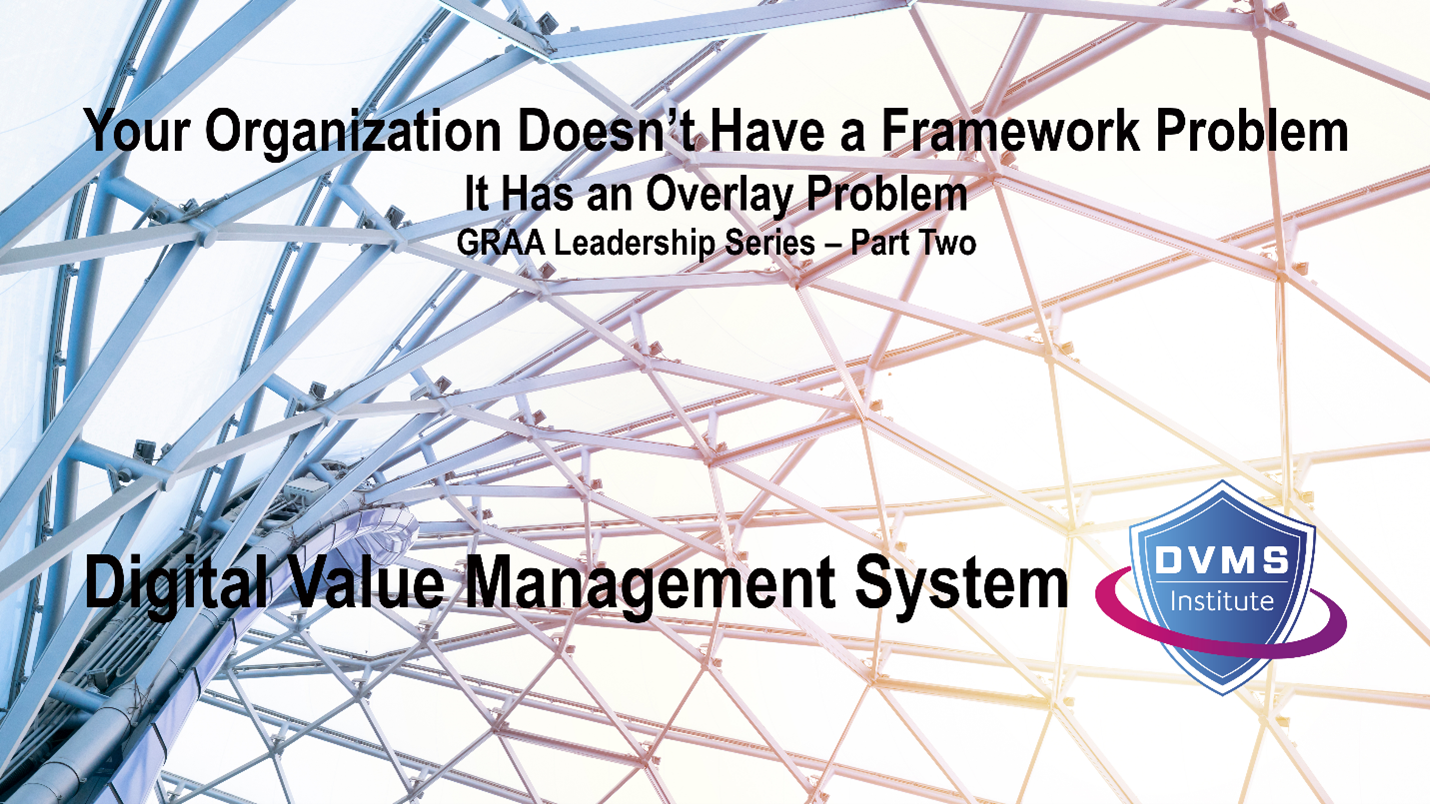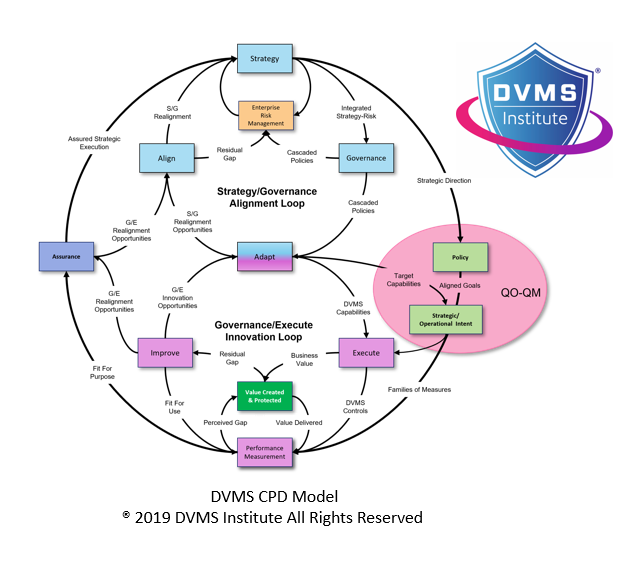What is Fragmented Governance and Why Organizations Need to Fix It NOW!
Rick Lemieux – Co-Founder and Chief Product Officer of the DVMS Institute
Fragmented governance refers to the condition in which an organization or ecosystem’s oversight, decision-making, and policy enforcement processes are dispersed across multiple, poorly coordinated entities or functions. Instead of operating as a cohesive whole, the governance landscape is characterized by disconnected frameworks, conflicting priorities, and unclear lines of accountability. This fragmentation can occur at various levels—within a single enterprise, across departments, or between multiple organizations in a sector or supply chain. The result is an environment where decisions are made in silos, policies are inconsistently applied, and oversight mechanisms operate without complete visibility into the broader strategic or operational context.
Origins and Causes of Fragmented Governance
The roots of fragmented governance are diverse. One common cause is organizational silos, where departments such as IT, compliance, finance, and operations operate semi-independently with their governance processes, metrics, and reporting structures. Over time, these silos become entrenched, often reinforced by legacy systems, cultural barriers, and differing professional languages or priorities.
Another contributor is framework proliferation. Organizations adopt multiple standards, regulatory regimes, and industry frameworks—ISO standards, NIST guidelines, Regulatory requirements, sector-specific compliance mandates—without aligning them into a unified governance model. Instead of harmonizing these tools, each framework is implemented in isolation, leading to overlap, duplication, and even contradictions in requirements.
Mergers, acquisitions, and rapid organizational growth can also exacerbate fragmentation. New business units often arrive with their governance practices, and integrating them into a single coherent system takes deliberate effort, which is sometimes deferred in favor of operational priorities. Additionally, global operations introduce jurisdictional differences in regulation and enforcement, creating another layer of complexity that can fragment governance if not correctly managed.
Characteristics of Fragmented Governance
Several symptoms make fragmented governance identifiable:
- Inconsistent Policies and Standards – Policies vary between departments or regions, resulting in uneven enforcement and potentially conflicting operational rules.
- Duplicated Efforts – Multiple teams perform similar compliance or audit activities without coordination, wasting resources.
- Gaps in Oversight—No single body has a comprehensive view of governance activities, allowing risks to slip through the cracks.
- Reactive Decision-Making – Governance responses tend to be driven by crises or audits rather than proactive, strategic planning.
- Limited Cross-Functional Communication – Teams lack a shared vocabulary and context for governance issues, impairing collaboration.
These characteristics weaken governance effectiveness and erode stakeholder confidence in the organization’s ability to manage its responsibilities consistently.
Risks and Consequences
The risks of fragmented governance extend across operational, strategic, and reputational dimensions.
From a strategic perspective, fragmented governance undermines the alignment of risk management with organizational goals. When governance is fractured, leadership may receive incomplete or inconsistent information, impairing their ability to make informed strategic decisions. This can lead to missed opportunities, investments in low-priority areas, or unmitigated risks that later escalate into crises.
From an operational perspective, disconnected governance can create bottlenecks, delays, and inefficiencies. For example, if the IT department implements a new cybersecurity tool without coordinating with compliance teams, it may fail to meet specific regulatory reporting requirements, necessitating costly rework.
From a reputational perspective, stakeholders, including regulators, customers, and investors, expect organizations to demonstrate consistent and transparent governance practices. Fragmentation can lead to compliance failures, security breaches, or ethical lapses that damage trust and invite scrutiny. In regulated industries, such lapses can result in fines, sanctions, or loss of operating licenses.
The Link to Digital and Cybersecurity Challenges
Fragmented governance is particularly dangerous in the digital era. The interconnected nature of systems, processes, and data flows means that a governance gap in one area can have cascading effects across the organization.
Cybersecurity governance, for instance, often suffers when IT security teams, risk managers, and compliance officers operate in silos. Without a unified governance framework, cybersecurity investments may be misaligned with actual threat priorities, incident responses may be uncoordinated, and post-incident reviews may fail to drive systemic improvement. The rapid adoption of emerging technologies such as Artificial Intelligence can amplify these risks if governance mechanisms for ethics, transparency, and accountability are not integrated into the innovation process.
Fragmented Governance in Multi-Stakeholder Environments
Fragmented governance can arise from differing mandates, priorities, and governance cultures among stakeholders in complex ecosystems- such as supply chains, industry alliances, or public-private partnerships. For example, in a global supply chain, a manufacturer, logistics partners, and suppliers may each have their own governance standards for quality, security, and sustainability. These differing standards can create friction, increase costs, and leave the ecosystem vulnerable to weakest-link failures without harmonization.
Cross-border initiatives face additional hurdles due to divergent legal systems, regulatory requirements, and cultural approaches to governance. Achieving alignment requires deliberate negotiation, shared frameworks, and mechanisms for continuous collaboration.
The Human and Cultural Dimension
Governance is not purely structural—it is also shaped by organizational culture. Fragmentation often reflects deeper cultural divides, such as mistrust between departments, competition for resources, or resistance to change. Leaders may guard their autonomy by resisting efforts to integrate governance processes, perceiving them as threats to their authority or identity.
Cultural fragmentation also affects how governance policies are interpreted and applied. If risk awareness and accountability are not embedded in the culture, policies may be followed superficially or selectively. Conversely, a culture that values transparency, cross-functional collaboration, and shared responsibility can help bridge governance gaps even before formal structures are unified.
The Case for Integration
The antidote to fragmented governance is an integrated governance model—a unified approach that aligns policies, processes, and oversight mechanisms across the organization. Integration brings several benefits:
- Holistic Risk Management – A unified governance framework enables the organization to identify and address risks interconnectedly, rather than in isolated pockets.
- Operational Efficiency – Reducing duplication of effort frees up resources for strategic initiatives.
- Strategic Alignment – Integrated governance ensures decision-making supports organizational goals and adapts to changing conditions.
- Regulatory Confidence – Consistent application of standards builds trust with regulators and external stakeholders.
Integration can be achieved through systems that overlay and unify existing processes, such as the Digital Value Management System® (DVMS) from the DVMS Institute. This approach delivers seamless integration while establishing a common language and structured framework for governance. This enables diverse functions to collaborate effectively, preserve their specialized expertise, and operate as part of a cohesive whole
Overcoming Barriers to Integration
While the benefits of integration are clear, overcoming fragmentation requires deliberate effort. Common barriers include:
- Legacy Systems and Processes – Older systems may not easily interface with new governance tools, requiring investment in integration.
- Resistance to Change – Leaders and teams accustomed to autonomy may push back against centralized governance.
- Complexity of Alignment – Merging multiple frameworks and regulatory regimes into a coherent whole can be technically and administratively challenging.
Organizations can adopt phased approaches to address these barriers, starting with pilot projects demonstrating the integration’s value. Change management strategies—such as clear communication, leadership sponsorship, and incentives for cross-functional collaboration—are critical to success.
Conclusion: From Fragmentation to Enabling Cyber Operational Resilience, Regulatory Compliance, and Digital Trust Outcomes
Fragmented governance is more than an administrative inconvenience—it is a structural weakness that can undermine performance, compliance, and trust. The cost of ignoring governance gaps is growing in today’s interconnected, high-velocity digital environment. Governance must be cohesive, transparent, and strategically aligned in enterprise risk management, cybersecurity, regulatory compliance, or ethical oversight.
Moving from fragmentation to integration is not merely about centralizing authority—it is about building a governance ecosystem that fosters shared accountability, consistent application of standards, and informed decision-making. By unifying governance, organizations can better respond to emerging risks, capitalize on opportunities, and maintain the trust of stakeholders in an increasingly complex world.
About the Author

Rick Lemieux
Co-Founder and Chief Product Officer of the DVMS Institute
Rick has 40+ years of passion and experience creating solutions to give organizations a competitive edge in their service markets. In 2015, Rick was identified as one of the top five IT Entrepreneurs in the State of Rhode Island by the TECH 10 awards for developing innovative training and mentoring solutions for boards, senior executives, and operational stakeholders.
In today’s digitally driven economy, cyber disruptions are no longer an “if” but a “when.”
The DVMS Institute’s Certified Training Programs teach organizations the skills to build a Holistic, Adaptive, and Culture-Driven Overlay System that turns fragmented digital governance, assurance, and culture into a unified Digital Value Management System® capable of driving Cyber Operational Resilience, Regulatory Compliance, and Digital Trust outcomes.
The DVMS powers its unified digital value management system through an ecosystem of existing frameworks, standards, and regulatory requirements integrated and operationalized by the DVMS MVC, CPD, and 3D Knowledge overlay models.

Achieving true cyber operational resilience, regulatory compliance, and digital trust requires seamless alignment between organizational Strategy, Governance, and Operations, underpinned by a culture dedicated to sustaining and continuously innovating the Creation, Protection, and Delivery of organizational digital value.
This systems-based approach to cyber operational resilience, regulatory compliance, and client trust demands active engagement from all members of the Digital Ecosystem, with each member playing a distinct role in proactively identifying and mitigating the systemic risks that threaten digital business operations.
This forward-looking approach to Adaptive Governance, Integrated Assurance, and Cultural Resilience positions businesses to:
- Maintain Operational Stability Amidst Constant Digital Disruption
- Deliver Digital Value, and Trust Across A Digital Ecosystem
- Satisfy Critical Regulatory and Certification Requirements
- Leverage Cyber Resilience as a Competitive Advantage
DVMS Explainer Videos
- Architecture Video: David Moskowitz explains the DVMS System
- Case Study Video: Dr. Joseph Baugh Shares His DVMS Story.
- Overlay Model – What is an Overlay Model
- MVC ZX Model – The MVC’s that power operational resilience
- CPD Model – Adaptable governance and assurance
- 3D Knowledge Model – Enabling holistic organizational learning
- FastTrack Model – A phased approach to cyber resilience
Digital Value Management System® is a registered trademark of the DVMS Institute LLC.
® DVMS Institute 2025 All Rights Reserved




